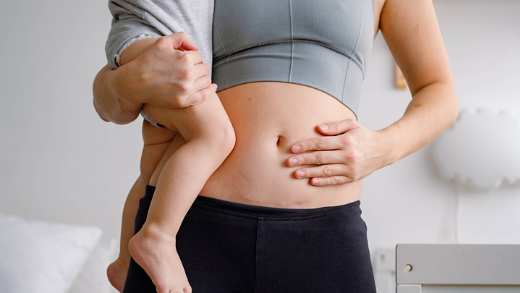Caesarean section – The operation and recovery
A caesarean section is when your baby is delivered through a cut in your stomach rather than a vaginal birth.

A caesarean section, often called a C-section, is an operation where your baby is delivered through a cut in your stomach. It’s usually performed when there are complications in your pregnancy and doctors feel it’s safer than a natural delivery.
In the UK around 1 in 4 pregnant women have a caesarean delivery Footnote [1]. It’s a major operation which carries some risks and has a slightly longer recovery time than a vaginal birth.
Why do I need a C-section?
Emergency caesarean section
The healthcare team looking after you during labour sometimes have to make quick decisions if something isn’t right. There are many reasons they might decide your baby needs to be delivered immediately. Some of these are Footnote [1]:
- Your baby is not getting enough oxygen or is becoming distressed.
- Labour is not progressing as it should, or has gone on too long.
- There’s severe vaginal bleeding (haemorrhage).
- There is a life-threatening emergency for you or your baby.
- The umbilical cord prolapses (comes out ahead of your baby).
Elective caesarean section
If doctors want to avoid complications during labour – such as in the case of multiple births – or if there have been difficulties with a previous birth, they may recommend an elective (planned) caesarean.
Or, if problems develop during your pregnancy, doctors may decide an elective C-section is the best option. This could be because Footnote [1]:
- Your baby is in a breech (bottom or feet down) or transverse (sideways) position and can’t be turned by midwives pressing on your stomach.
- You have high blood pressure, called pre-eclampsia, during pregnancy.
- You have a viral infection which may affect the baby if it’s delivered vaginally.
- You have a problem with the placenta – it’s either in the wrong position or failing.
Elective caesareans are usually done a week or two before your due date. You may have some say in the date, but your doctor or birth team will advise you on what’s best.
Requested C-section
You can choose to have your baby delivered by C-section, without a medical reason. But it’s a good idea to talk to your midwife or consultant early in the pregnancy and discuss your reasons and the pros and cons.
Preparing for a planned C-section
Once you have your date for your caesarean delivery you’ll be able to arrange to have someone help you in the first few weeks when you get home. This is important as you won’t be able to lift anything heavy, or drive, at first.
The hospital will give you instructions about how long before the operation you need to stop eating and drinking and you’ll need to follow them.
You may be given antibiotics to take beforehand to reduce the chance of getting an infection after the C-section. You may also have swabs taken from your skin to check for MRSA (a type of bacteria) and have a blood test to confirm your blood group and check your iron levels.
When you arrive at the hospital you’ll change into a hospital gown and be given a wrist and ankle identification band. You may also be asked to shave an area of pubic hair if necessary.
What happens in a C-section procedure?
Depending on your circumstances and how urgent the caesarean is, you’ll have either a spinal or epidural anaesthetic (where you’re awake) or a general anaesthetic (where you’re asleep).
Spinal/epidural anaesthetic
If you’re going to be awake, you’ll have anaesthetic injected into the epidural space in your spine. You’ll be asked to lie on your side while the anaesthetist does this. A local anaesthetic will be applied first to numb your skin and help with pain relief.
You’ll be attached to equipment to monitor your blood pressure, oxygen levels and heart rate, and a cannula will usually be inserted into a vein in your hand or arm. This is a small plastic tube, put in place in case the medical team need to administer fluids or medication.
You’ll start to notice that your legs feel tingly and numb and the sensation will spread upwards to the middle of your chest.
The medical team will insert a catheter into your bladder. This is a thin flexible tube which empties your bladder while you’re under the anaesthetic.
You’ll be allowed to choose a birthing partner to be with you, and some hospitals allow you to choose music to play during the operation.
General anaesthetic
Similar to being awake, for a general anaesthetic you’ll be monitored and will have a cannula in your arm. You may be given an antacid to drink and tablets to reduce stomach acid.
You’ll have a face mask on for you to breathe in pure oxygen, as the anaesthetic to send you to sleep is delivered through the cannula.
Your birth partner won’t be in theatre with you, but can wait in the recovery area and receive the baby when it’s born.
The C-section delivery
A cut about 10-20 cm long will be made across your lower stomach and womb, just below your bikini line. Sometimes doctors make a vertical cut just below your belly button.
You’ll feel some tugging and pressure during the procedure, but it won’t hurt. When your baby is delivered you’ll be able to see and hold it straight away.
To encourage the womb to contract and reduce blood loss, you’ll be given an injection of oxytocin after your baby is delivered.
The operation takes about 40-50 minutes, with your baby being born about 10 minutes in.
C-section recovery
After your caesarean delivery you’ll be moved to the recovery room and the medical team will look after you.
You’ll be offered painkillers, and if you’ve had a spinal or epidural you’ll feel the anaesthetic starting to wear off in your legs and lower body. This might feel like a tingling sensation as full feeling comes back. You’ll need to stay in bed until you can walk safely.
If you’ve had a general anaesthetic, you’ll feel sleepy for a couple of hours and might have a sore throat.
Once you’re up and able to walk, you’ll be able to have the catheter removed from your bladder.
If you’re hungry or thirsty you’ll be offered food and drink, and if you need assistance with your baby – such as breastfeeding - your midwife will be there to help.
The cut on your stomach will have been closed with dissolvable stitches or staples and a dressing applied over it.
When you get home
Once you’re home, you’ll need to be careful with your wound and wear loose clothing. The midwife will visit and check and change your dressing if necessary. They’ll also remove any stitches or clamps. Once the dressing is removed, you’ll need to gently clean and dry your wound every day, while watching out for any signs of infection.
Your wound will feel sore and you’ll be advised to take pain relief for up to 10 days after your C-section. Your doctor or midwife will tell what pain relief is best, especially if you’re breastfeeding.
To prevent blood clots you’ll probably be given compression stockings to wear, and injections of blood-thinning medicine. You’ll have to continue with the injections for up to six weeks, at home – injecting yourself daily. Keeping active and drinking lots of water will also reduce your risk of blood clotting.
You can usually start driving again after six weeks, once you’ve been told it’s safe to do so by your doctor.
Risks of a C-Section
It’s important to remember that a C-section is a major operation and will normally take more time to recover from than a natural birth. Although it’s largely safe, any general anaesthetic and surgery can come with complications.Footnote [2]
- Your wound may be sore for weeks and can sometimes become infected.
- You may develop a womb infection – symptoms include fever, abnormal vaginal discharge, stomach pains and heavy vaginal bleeding.
- A less common complication is excessive bleeding which doesn’t stop and would need medical attention.
- Rarely, some new mums suffer with a blood clot in their leg called a DVT (deep vein thrombosis).
- Also rare is damage to your bladder or internal tubes around the kidneys and bladder which may require further surgery.
When everything is healed you’ll be left with a C-section scar. Most scars are low enough down to be covered by your underwear.
You could use your cover to pay for treatment for a C-section
You could claim for treatment for a C-section using your health insurance cover. You can make a claim through MyAviva, over the phone, or online. You can view the range of conditions we cover in your policy terms and conditions.
If we confirm that your claim meets the terms of your policy, we’ll pay for the treatment directly. Just be sure to tell us if you need more tests or treatment, or if your hospital or specialist changes.
It’s good to have one less thing to worry about. It takes Aviva.
^ These services are non-contractual and can be withdrawn or amended by Aviva at any time.
Wellbeing services
Digital GPs, health checks, gym discounts and Stress Counselling helpline — find out more about how Aviva can help support your mental and physical wellbeing.



